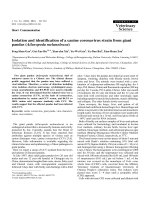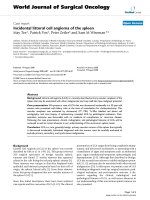báo cáo khoa học: " Incidental giant renal oncocytoma: a case report" potx
Bạn đang xem bản rút gọn của tài liệu. Xem và tải ngay bản đầy đủ của tài liệu tại đây (306.75 KB, 2 trang )
CAS E REP O R T Open Access
Incidental giant renal oncocytoma: a case report
Anastasios Anastasiadis
1*
, Georgios Dimitriadis
2
, Dimitrios Radopoulos
2
Abstract
Introduction: Large renal oncocytomas are not very rare entities. To the best of our knowledge, we report one of
the largest oncocytomas in the English literature. The tumor was incidentally diagnosed and, based on the
preoperative clinical and radiographic findings, was therefore considered to be a renal cell carcinoma.
Case presentation: A 48-year-old Caucasian diabetic man had an abdominal ultrasound for chronic abdominal
discomfort, which revealed a large mass on the left kidney. An abdominal computed tomog raphy scan revealed a
contrast enhancing, well defined, heterogenous large mass (16.5 × 13.9 cm) originating from the left lower pole
with cystic and solid areas. A magnetic resonance imaging scan was performed with no evidence of renal vein or
caval thrombus or embolus. A radical nephrectomy was performed through a left flank intercostal incision and the
pathology diagnosed renal oncocytoma. The postoperative course was uneventful and the patient was discharged
six days later.
Conclusion: Several reports have characterised this essentially benign renal histiotype, which represents 5% to 7%
of all solid renal masses. Unfortunately, most renal oncocytomas cannot be differentiated from malignant renal cell
carcinomas by clinical or radiographic criteria. Central stellate scar and a spoke-wheel pattern of feeding arteries
are unreliable diagnostic signs and are of poor predictive value. These tumors are treated operat ively with radical
or partial nephrectomy or thermal ablation, depending on the clinical circumstances. We report on, to the best of
our knowledge, the fourth largest lesion of this type of renal patholo gy.
Introduction
Despite t he fact that oncocytomas tend to be relatively
smaller and asymptomatic than renal cell carcinomas
(RCCs), they cannot be reliably distinguished preopera-
tively. The variable nature o f their presentation and the
overlap of radiographic characteristics between these
lesions complicate their clinical differentiation [1]. This
case report illustrates the difficulty in the preoperative
diagnosis of even very large, contrast-enhancing renal
masses and underscores the inclusion of renal oncocy-
toma in the differential diagnosis of these lesions.
Case presentation
A 48-year-old diabetic Caucasian man had an ultra-
sound of the abdomen for chronic abdominal discom-
fort, which revealed a large mass of the left kidney.
There was no flank pain or any other relevant clinical
symptoms. His previous personal and family history was
noncontributory. At physical examination a firm mass
was palpated in left upper abdominal quadrant.
Blood tests, including renal and liver function, were
normal except for glucose; urine analysis and chest X-ray
were also normal. Computed tomography revealed
an enhancing well-defin ed heterogeneous large mass of
16.5 × 13.9 cm originating from the lower po le of the left
kidney, with cystic and solid areas within the mass.
A magnetic resonance imaging scan was performed in
order to fu rther evaluate the renal artery and vein, which
showed no evidence of renal vein or caval thrombus or
embolus. Due to the possibility of renal malignancy, radi-
cal nephrectomy was performed through a left flank
intercostal incision.
There were no postoperative complications and the
patient was discharged six days after the operation. The
specimen weighed 1973 g and the dimensions were 27 ×
16 × 13 cm. Histopathology diagnosed a renal oncocy-
toma. No islets of renal cell carcinoma and no evidence
of necrosis or bleeding were found. No vascular or capsu-
lar invasion was detected. The maximal diameter of the
tumor was 16 cm. Immunohistochemistry was positive
* Correspondence:
1
13 Kafantari Street, 55132 Thessaloniki, Greece
Full list of author information is available at the end of the article
Anastasiadis et al. Journal of Medical Case Reports 2010, 4:358
/>JOURNAL OF MEDICAL
CASE REPORTS
© 2010 Anastasiadis et al; licensee BioMed Central Ltd. This is an Open Access article distributed under the terms of the Creative
Commons Attribution License ( 0), which permits unrestricted use, distribution, and
reproduction in any medium, provided the original work is prope rly cited.
for epithelial membrane ant igen and parvalbumin and
negative for vimentin, CK7 and CD10, which further sup-
ported the initial diagnosis (Figure 1).
Discussion
Oncocytoma is the second most common solid tumor of
the kidney after RCC. They both originate from distal
tubules and histologic similarities do exist, particularly
for the esinophilic variant of the chromophobic carci-
noma. To date, Demos et al. [2] have reported th e largest
and heaviest oncocytoma, which measured 27 × 20 ×
15 c m and weighed 4652 g. Banks et al.[3]reportedthe
second heaviest renal oncocytoma (3090 g, 21 × 18 ×
15 cm) and Kilic et al. [4] reported the third heaviest
oncocytoma (2680 g, 20 × 15 × 10 cm). Unfortunately,
most renal oncocytomas cannot be differentiated from
malignant RCC by clinical or radiographic criteria.
Common imaging findings are central stellate scar and
spoke-wheel pattern of feeding arterie s but are usually
unreliable for preoperative differential diagnosis [5,6].
Consequently, these tumors should be treated operatively
like RCC with radical or partial nephrectomy and, alter-
natively, with thermal ablati on, depend ing on th e clinical
circumstances. Even when very large, they are generally
well encapsulated and are rarely invasive or associated
with metastases [7].
Common cytogenetic findings for oncocytomas include
the loss of the first and Y chromosomes, a loss of hetero-
zygosity on chromosome 14q and rearrangement at
11q13. On the contrary, abnormalities of chromosomes 3,
7 and 17 are rarely found in association with oncocytomas.
The genetic alteration s observed with renal oncocytomas
are thus char acteristic and distinct from those described
for the various subtypes of RCC. Despite their benign
behavior, however, oncocytomas should be monitored
closely and treated if there is evidence of rapid growth or a
coexisting RCC, which occurs in 10% to 32% of reported
patients [1].
Conclusion
Several reports have characterized this essentially benign
renal pathology which represents 3% to 7% of all solid
renal masses. Unfortunately, most renal oncocytomas
cannot be differentiated from malignant RCCs by clini-
cal or radiographic evidence [6]. We report, to the best
of our knowledge, t he fourth largest lesion of this type
of renal pathology.
Consent
Written consent was obtained from the patient for pub-
lication of the case report and any accompanying
images. A copy of the written consent is available for
review by the Editor-in-Chief of the journal.
Abbreviations
EMA: epithelial membrane antigen; RCC: renal cell carcinoma.
Author details
1
13 Kafantari Street, 55132 Thessaloniki, Greece.
2
Gennimatas Hospital, 41
Ethnikis Aminis Street, Thessaloniki, Greece.
Authors’ contributions
AA conceived the study concept and design, was involved with patient care
and drafted the manuscript and literature review. DG and RD were involved
with the formation of the study concept and its design, patient care, the
drafting of the manuscript and the literature review. RD and AA carried out
the operation on the patient. All authors have read and approved the final
version of the manuscript.
Competing interests
The authors declare that they have no competing interests.
Received: 29 January 2010 Accepted: 8 November 2010
Published: 8 November 2010
References
1. Chao DH, Zisman A, Pantuck AJ, Freedland SJ, Said JW, Belldegrun AS:
Changing concepts in the management of renal oncocytoma. Urology
2002, 59(5):635-642.
2. Demos TC, Malone AJ Jr: Computed tomography of a giant renal
oncocytoma. J Comp Assist Tomogr 1988, 12(5):899-900.
3. Banks KL, Cherullo EE, Novick AC: Giant renal oncocytoma. Urology 2001,
57(2):365-366.
4. Kiliç S, Altinok MT, Ipek D, Ergin H: Case report of a giant renal
oncocytoma. Int Urol Nephrol 2003, 35(1):83-84.
5. Shin LK, Badler RL, Bruno FM, Gupta M, Katz DS: Radiology-pathology
conference: bilateral renal oncocytomas. Clin Imaging 2004, 28(5):344-348.
6. Campbell CS, Novick CA, Bukowski MR: Renal Tumours. In Campbell’s
Urology. Volume 2. 9 edition. Philadelphia: WB Saunders; 2007:1567-1637.
7. Dechet CB, Bostwick DG, Blute ML, Bryant SC, Zincke H: Renal oncocytoma:
multifocality, bilateralism, metachronous tumor development, and
coexistent renal cell carcinoma. J Urol 1999, 162(1):40-42.
doi:10.1186/1752-1947-4-358
Cite this article as: Anastasiadis et al.: Incidental giant renal oncocytoma:
a case report. Journal of Medical Case Reports 2010 4:358.
Figure 1 Preoperative magnetic resonance imagi ng (MRI) scan.
T2-weighted sagittal MRI.
Anastasiadis et al. Journal of Medical Case Reports 2010, 4:358
/>Page 2 of 2









